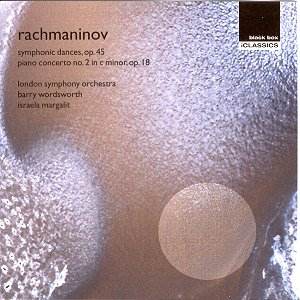Sergei RACHMANINOV
Symphonic Dances, op.45,
Piano Concerto no.2 in c, op.19*
 Israela Margalit
(pianoforte)*,
Israela Margalit
(pianoforte)*,
London Symphony Orchestra/Barry Wordsworth
Recorded Abbey Road Studios, London, undated but pub. 1992
 BLACK BOX BBM 3001
[73.33]
BLACK BOX BBM 3001
[73.33]
Crotchet
£5.99
AmazonUK
£6.99 AmazonUS
Amazon
recommendations

There are a number of ways of going about the Symphonic Dances. You can be
brilliantly Russian, with violent explosions of colour and the big tunes
not too romantic but searingly passionate. Or you can emphasise the doleful,
death-haunted aspects with broad tempi (I must say I like the first dance
to be pretty deliberate) and a smouldering, Shostakovich-anticipating tension.
Either of these ways brings out the relative modernity and forward-looking
aspects of the score. Another way is to give the orchestra a fairly relaxed
guide at in-between tempi. This could be a recipe for dullness, or for a
non-interpretation, but not here when the orchestra is so good and everyone
sounds so involved. If the conductor does not sock a punch, his guiding hand
is there, keeping the rhythms from sagging in the lugubrious central waltz
and timing well the many transitions. What this approach does emphasise is
the more backward-looking aspects of the score, its Scriabinesque decadentism.
Which is perfectly reasonable and some may prefer it this way.
I presume the two works were recorded at separate sessions but Israela Margalit's
bemused manner with the opening solo sounds exactly as if she has just been
knocked for six by the final gong stroke of the last dance. With the timing
exactly right it is an inspired moment and I'd dearly like to know if it
was intended to be so.
In another context I'd have found this opening too pulled around, but the
performance doesn't continue like that. It is an extremely musical performance.
Margalit retains a clear, limpid sound in even the most strenuous moments,
and finds brilliance and tenderness as required. I noticed at times that
her tone is not always a singing one, but nor is it hard. Co-ordination with
the orchestra seems a little shaky in the first paragraph but thereafter
a real partnership emerges (a well-balanced recording, too). Jaded as one
can get with this concerto I realised at the end that I had listened with
complete enjoyment and that some moments - the epilogue of the slow movement
and the close of the whole work which avoids inflation by sheer sincerity
- had moved me more than they have done for a very long time. I suppose I'll
never part with Richter in this concerto - especially perhaps the version
conducted by Kondrashin, where the shared inheritance of Russian gloom on
the part of pianist, conductor and orchestra reaches unforgettable heights
in the slow movement - and I wish Edith Farnadi's version with Hermann Scherchen
(on Westminster) could be reissued; and on balance I'll stay with Ormandy
for the Dances. But a great deal of pleasure is to be had here.
One last remark. Aren't Black Box supposed to be a rather underground, off-beat
organisation? Surely this record is dangerously close to popular all-the-family
listening? (There is an original feature. The notes are the size of
a postage stamp but if you put the CD in your computer you get access to
an information-packed website. Except that it was temporarily suspended the
evening I tried so I can't comment). But might not it have been more in Black
Box's line to essay a disc of Symphonic Dances, maybe putting the Rachmaninov
work alongside Ravel's La Valse, Frank Bridge's Dance Poem
(absolutely the equal of the other two) and Sibelius's Valse Triste
(arguably not, but you have to sell the disc somehow)? Do your stuff, Black
Box!
Christopher Howell

